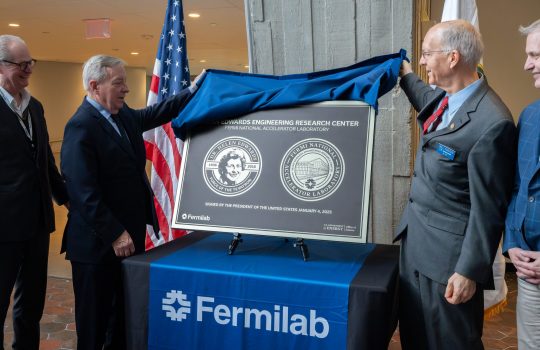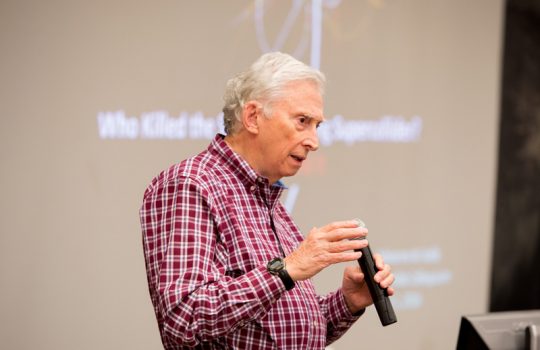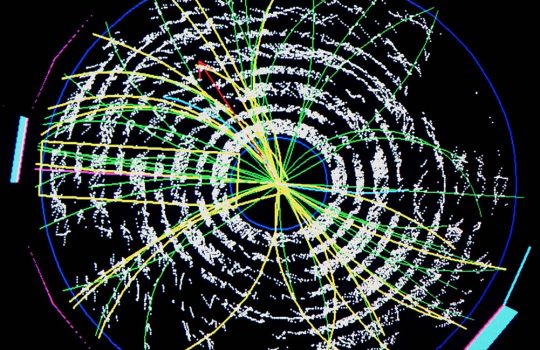Batavia, Illinois–Scientists of the CDF and DZero experiments at the Department of Energy’s Fermi National Accelerator Laboratory presented today (April 15) at the annual April meeting of the American Physical Society the latest results of intriguing measurements made with the Tevatron particle collider. Highlights of the presentations were the observation of rare particle processes never observed before and new constraints on the mass of the Higgs boson, which in principle make the observation of this elusive particle at the Fermilab Tevatron collider more likely. Based on the world’s best measurements of the top quark mass and the W boson mass, the new upper limit for the mass of the Higgs boson is now 144 GeV/c2 with 95 percent probability.
More than 60 scientists working on the Tevatron experiments are presenting results at the APS meeting in Jacksonville, Florida. They are showing results for the rare production of single top quarks, one of the rarest collision processes ever observed at a hadron collider; a new measurement of the top quark mass; the first observation of events that simultaneously produce a W boson and a Z boson, an important milestone in the search for the Higgs boson; an update on measurements of bottom quarks, including Bs oscillations; and searches for new particles predicted by Supersymmetry and other theoretical models. These searches have led to more stringent constraints on the masses of supersymmetric particles and forces associated with such particles.
The steadily increasing number of collision events produced by the Tevatron as well as the innovative analysis methods employed by CDF and DZero scientists bode well for future discoveries. In particular, the direct experimental exclusion of a Higgs boson with a mass near 160 GeV/c2 seems to be within reach while searches for a Higgs boson with lighter mass will require more data. The Tevatron experiments will collect 2-3 times more data in the next two years. This will give the two experiments access to extremely rare subatomic processes, including access to a significant region of the expected Higgs mass range.
Here is a summary of the key results obtained by the Tevatron experiments, presented at a press conference at the APS conference in Jacksonville, Florida, on April 15:
I. The top quark and the Higgs, presented by Kevin Lannon, Ohio State University:
- Combining their latest measurements, the Tevatron experiments find the value of the top quark mass to be 170.9 GeV/c2, with an uncertainty of only 1 percent. This precision already exceeds the goal set for the entire duration of Tevatron Collider Run II, which is expected to continue until 2009. This new top quark mass value lowers the predicted range of allowed Higgs boson mass.
- The DZero collaboration has observed the first evidence of single top quarks produced in a rare subatomic process involving the weak nuclear force. The result is an important test of predictions made by particle theory, such as the number of quarks that exist in nature. The measurement yields the first constraints on the electroweak parameter Vtb, which is related to the probability of the top quark decaying into bottom quark. The observation of single top quarks validates new analysis techniques that provide scientists with improved tools to search for the Higgs boson.
II. W and Z bosons and the Higgs, presented by Gerald Blazey, Northern Illinois University:
- Both Tevatron experiments have recorded candidate events for the production of a pair of Z bosons in a single collision, with the CDF experiment reporting a first value of the cross section of this process. The ZZ process is the final step before reaching the even rarer process of a Higgs boson decaying into a pair of W bosons.
- The CDF collaboration recorded 16 collisions that produced simultaneously a W boson and a Z boson, a milestone on the path to discovering the Higgs. The WZ cross section is one of the rarest ones ever measured.
- The CDF collaboration has produced the world’s best individual measurement of the W mass, better than measurements made by any other single experiment, despite the large backgrounds that hadron colliders such as the Tevatron produce compared to the “cleaner” collision environments at lepton colliders. Combining the CDF result with other measurements worldwide leads to a lower average value of the W-boson mass of 80,398 +/- 25 MeV/c2, representing a precision of 3 parts in 10,000.
- The new upper limit for the mass of the Higgs boson based on the new values for the W boson mass and the top quark mass is 144 GeV/c2 with 95 percent probability.
- The experimental sensitivity for directly observing the Higgs boson is steadily improving. The Tevatron experiments are within reach of directly excluding a Higgs boson with mass near 160 GeV/c2. Searches for a Higgs boson with lighter mass will require more data.
III. Searches for non-Standard Model Higgs bosons and exotic particles, presented by Ulrich Heintz, Boston University:
- Scientists think that dark matter is made of particles not accounted for in the Standard Model of Particles and Forces. A leading candidate for dark matter particles are supersymmetric particles such as charginos and neutralinos. The Tevatron experiments have greatly extended the constraints on the properties of these particles.
- The Tevatron experiments have set new limits on a variety of particles predicted by Supersymmetry and other beyond-Standard Model theories. For example, DZero and CDF set new lower limits on the mass of non-standard W and Z bosons of 965 and 923 GeV/c2, respectively.
Notes for editorsFermilab is a Department of Energy Office of Science national laboratory operated under contract by the Fermi Research Alliance, LLC. CDF is an international experiment of 700 physicists from 61 institutions and 13 countries. DZero is an international experiment conducted by about 700 physicists from 90 institutions and 20 countries. The experiments are supported by the U.S. Department of Energy, the U.S. National Science Foundation and a number of international funding agencies.



